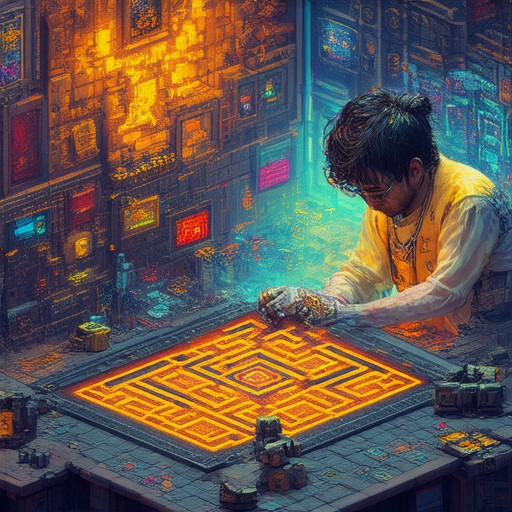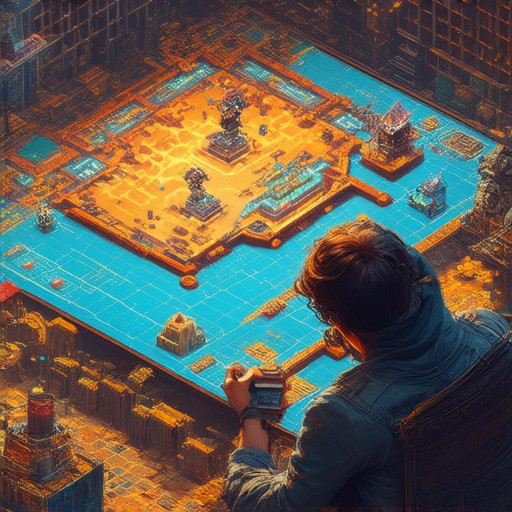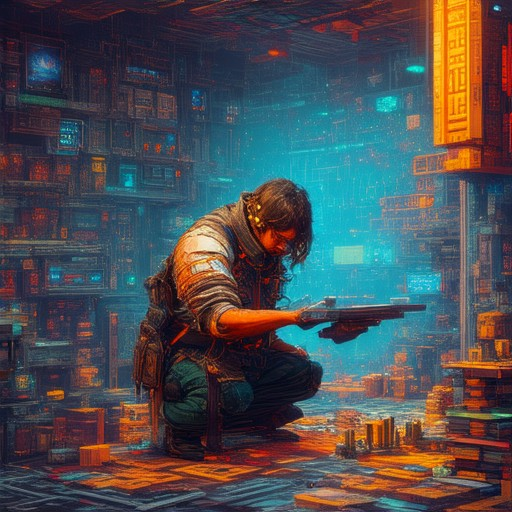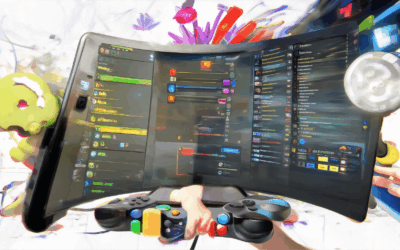Creating visually captivating isometric game art requires a blend of technical precision and creative insight. For those new to the craft, the process can feel overwhelming, especially when considering the array of tools, composition techniques, and stylistic choices available. Whether you’re a seasoned artist looking to refine your skills or a newcomer eager to dive into the world of game development, this guide offers expert tips and strategies to help you unlock the potential of isometric art. From mastering composition and color theory to understanding anatomy and optimizing your workflow, we’ll explore everything you need to know to create stunning isometric game art. By leveraging the right tools, embracing innovative trends, and staying ahead of industry developments, you can elevate your creations to new heights and leave a lasting impact on players worldwide. Let’s embark on this journey together and uncover the secrets behind crafting immersive and visually striking isometric game art.

How to Create Isometric Game Art
Creating isometric game art involves a combination of understanding perspective, using the right tools, and applying effective artistic techniques. Here’s a step-by-step guide to help you master the craft:
- Understand Isometric Perspective : Isometric art creates a 3D effect using simplified shapes and lines. Start by studying examples from games like Firewatch and Stardew Valley . Practice drawing characters and environments on grid paper to maintain proper proportions.
- Tools and Setup : Use grid paper to ensure symmetry and balance. For digital artists, consider software like Adobe Illustrator with plugins specifically designed for isometric art. These tools often come with preset brushes and templates tailored for the style.
- Lighting and Shading : Imply light sources using hatching or darker shades. Use warm colors for highlights and cooler tones for shadows to add depth and realism to your scenes.
- Color Theory : Work with a limited palette to keep your artwork clean and focused. Experiment with color contrasts to evoke different moods while maintaining clarity in your designs.
- Daily Practice : Dedicate time each day to sketch. Start with simple character designs and gradually move on to full environments. Regular practice will help you develop consistency and improve your skills over time.
- Reference Studies : Use real-world references to inspire your art. Trace these references on grid paper to understand how objects are depicted in isometric style. Look for tutorials or guides on platforms like TutsPlus for additional insights.
- Skill Development : Break down the creative process into manageable steps. Focus on mastering one technique before moving on to the next. Review your work periodically to track your progress and make adjustments as needed.
By combining these techniques and continuously practicing, you’ll be able to create captivating isometric game art that brings your ideas to life. Remember to explore resources from platforms like Indie Dev Games for further guidance and inspiration.
Best Tips for Creating Isometric Game Art
Creating isometric game art requires a unique blend of technical skill and artistic vision. Here are some expert tips to help you master the technique:
- Perspective Mastery : Isometric art relies heavily on perspective. Learn to manipulate 3D models into 2D space, focusing on vanishing points and foreshortening effects.
- Lighting and Shading : Use lighting to create depth and dimension. Practice shading techniques to bring your scenes to life and add realism.
- Composition Techniques : Arrange elements in your scene to create balance and interest. Use leading lines and visual weight to guide the viewer’s eye.
- Color Theory : Understand how color affects mood. Use warm colors for cozy environments and cooler tones for mysterious or futuristic settings.
- Anatomy and Proportion : Study human and creature anatomy to create believable characters and figures. Pay attention to proportions for dynamic poses.
- Texture Detail : Add texture and detail to surfaces to enhance the three-dimensional effect. Use patterns and imperfections to make objects stand out.
- Horizon Line Focus : Draw a clear horizon line to establish depth and prevent your artwork from appearing flat. Use varying sizes and distances for background elements.
- Add Depth with Layers : Incorporate layers in your scenes to create a sense of distance and depth. Use overlapping elements to add complexity.
- Reference Lines : Use reference lines to maintain consistent proportions and spacing in your artwork. This helps in creating a cohesive and realistic scene.
- Experiment with Style : Don’t fear to try different styles and techniques. Isometric art can be minimalist, detailed, or abstract depending on your creative vision.
By mastering these tips, you’ll be able to create captivating and immersive isometric game art that stands out. Remember to practice regularly and study the works of experienced artists to continuously improve your skills.

Best Tips for Creating Isometric Game Art
Creating isometric game art requires a unique blend of technical skill and artistic vision. Here are some expert tips to help you master the technique:
- Perspective Mastery : Isometric art relies heavily on perspective. Learn to manipulate 3D models into 2D space, focusing on vanishing points and foreshortening effects.
- Lighting and Shading : Use lighting to create depth and dimension. Practice shading techniques to bring your scenes to life and add realism.
- Composition Techniques : Arrange elements in your scene to create balance and interest. Use leading lines and visual weight to guide the viewer’s eye.
- Color Theory : Understand how color affects mood. Use warm colors for cozy environments and cooler tones for mysterious or futuristic settings.
- Anatomy and Proportion : Study human and creature anatomy to create believable characters and figures. Pay attention to proportions for dynamic poses.
- Texture Detail : Add texture and detail to surfaces to enhance the three-dimensional effect. Use patterns and imperfections to make objects stand out.
- Horizon Line Focus : Draw a clear horizon line to establish depth and prevent your artwork from appearing flat. Use varying sizes and distances for background elements.
- Add Depth with Layers : Incorporate layers in your scenes to create a sense of distance and depth. Use overlapping elements to add complexity.
- Reference Lines : Use reference lines to maintain consistent proportions and spacing in your artwork. This helps in creating a cohesive and realistic scene.
- Experiment with Style : Don’t fear to try different styles and techniques. Isometric art can be minimalist, detailed, or abstract depending on your creative vision.
By mastering these tips, you’ll be able to create captivating and immersive isometric game art that stands out. Remember to practice regularly and study the works of experienced artists to continuously improve your skills.

What Are Some Tips for Creating Isometric Game Art?
Creating isometric game art requires a unique blend of technical skill and artistic vision. Below are some expert tips to help you master the craft:
- Start with a Strong Concept – Begin by visualizing your scene and planning the composition. Isometric art often relies on perspective and depth, so sketch rough ideas to guide your work.
- Use Grid Paper – A common technique among artists is to use grid paper to maintain consistent proportions and spacing, ensuring your art looks polished and professional.
- Focus on Lighting and Shadows – Lighting plays a crucial role in giving your scenes depth and dimensionality. Experiment with shading and highlights to bring your characters and environments to life.
- Practice Perspective Drawing – Mastering perspective is essential for creating the illusion of depth in isometric art. Practice drawing objects from various angles to understand how they appear in 3D space.
- Color Theory Matters – Use color strategically to evoke mood and differentiate surfaces. Learn how to apply gradients and shadows to create a realistic and visually appealing environment.
- Stay Consistent with Style – Develop a cohesive style by using consistent colors, textures, and character designs. This helps maintain a unified look across your project.
- Iterate and Refine – Don’t hesitate to revisit your work. Look for areas where you can improve details, lighting, or composition to enhance the overall quality of your art.
Looking to take your skills further? Explore our comprehensive tutorial library for more insights and guides on creating professional-quality game art. Whether you’re working on a mobile game, indie title, or personal project, our resources are designed to inspire and educate.
Expert Tips for Creating Stunning Isometric Game Art
Creating stunning isometric game art requires a blend of technical skill, creativity, and attention to detail. Here are some expert tips to help you master the craft:
1. Master Perspective and Shading
Isometric art relies heavily on perspective and shading to create depth and dimension. Practice drawing objects from a birds-eye view, ensuring that shadows and highlights fall naturally. Use light and dark tones to define shape and form, giving your scenes a three-dimensional feel.
2. Utilize the Right Tools
Whether you’re working digitally or traditionally, having the right tools is essential. Consider using software like Blender for 3D modeling and texture mapping, or Adobe Character Animator for 2D character creation. These tools offer powerful features to bring your isometric concepts to life.
3. Focus on Composition
Composition is key to making your isometric art visually appealing. Use a grid system to ensure symmetry and balance in your scenes. Pay attention to negative space and let it complement your subject rather than distract from it. Experiment with different camera angles to explore unique perspectives.
4. Incorporate Lighting Effects
Lighting can drastically change the mood of your scene. Use shading and highlights to create dramatic lighting effects. Try experimenting with ambient light, directional lights, and occlusion to add realism and depth to your artwork.
5. Learn Color Theory
Color theory plays a vital role in isometric art. Use warm colors to evoke warmth and cool colors to create a calming effect. Understand how colors interact with each other and how they can influence the overall atmosphere of your scene.
6. Iterate and Refine
Don’t hesitate to iterate on your designs. Take notes of what works and what doesn’t, then refine your pieces based on feedback. Every great artist goes through countless iterations, so embrace the process and keep experimenting until you’re satisfied with your results.
7. Explore Resources and Communities
Looking at inspiring art and learning from others can significantly boost your skills. Check out platforms like Indie Dev Games for tutorials, reviews, and tips from experienced artists. Engage with communities and share your progress to get constructive feedback and gain new insights.
By following these tips, you’ll be well on your way to creating captivating isometric game art that stands out. Keep experimenting, stay curious, and never stop learning!

What Are Some Expert Tips for Creating Stunning Isometric Game Art?
Creating stunning isometric game art requires a blend of technical skill, creativity, and attention to detail. Here are some expert tips to help you master the craft:
- Use the Right Tools : Start with professional software like Adobe Photoshop, Procreate, or Blender. These tools offer powerful features for creating detailed and precise isometric art.
- Master Lighting and Shadows : Lighting is essential in isometric art. Use shadows to create depth and realism, ensuring your scenes look three-dimensional and visually appealing.
- Understand Color Theory : Choose a color palette that complements your art style. Warm colors can add warmth, while cool colors can create a futuristic vibe. Balance is key to avoiding eye strain and enhancing visual appeal.
- Perspective is Key : In isometric art, perspective gives the illusion of depth. Use vanishing points to guide your eye movement, ensuring your artwork feels grounded and immersive.
- Add Detail Thoughtfully : Focus on small details to bring your scenes to life. Whether it’s textures, lighting effects, or subtle animations, details make your artwork stand out.
- Use Layers for Depth : Layer your elements to create a sense of distance and hierarchy. This technique helps guide the viewer’s eye and adds complexity to your scenes.
- Composition Matters : Arrange your elements in a way that leads the viewer’s eye through the scene. Use leading lines and balance to create a harmonious composition.
By following these tips, you can create isometric game art that captivates players and immerses them in your world. Experiment with different styles, techniques, and tools to find what works best for your project. Happy creating!




0 Comments